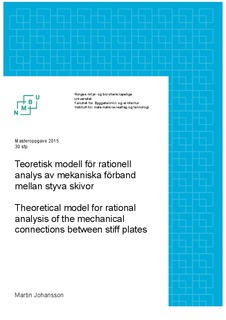| dc.contributor.author | Johansson, Martin | |
| dc.date.accessioned | 2015-07-28T07:53:37Z | |
| dc.date.available | 2015-07-28T07:53:37Z | |
| dc.date.copyright | 2015 | |
| dc.date.issued | 2015-07-28 | |
| dc.identifier.uri | http://hdl.handle.net/11250/293702 | |
| dc.description.abstract | In CLT buildings the properties and orientation of the mechanical connections are essential do they transfer the shear forces between the walls and floor slabs. Existing analysing methods of mechanical connections between CLT elements can be simplified hand calculations or advanced FEM analyses which can be time consuming and difficult to modulate properly. The CLT slabs are often connected both with wall to wall and wall to floor connections allowing the system of connectors to operate in three-dimensions.
A theoretical model for handling three-dimensional analyses between elastic connections and stiff slabs is described. The theory is implemented in Excel where a program is created to rationally analyse connections between CLT-structures.
An eight story high CLT building is analysed and the results reveals that the theory has a false assumption that the plates only could rotate in plane. The assumption causes a false locking of the connections that’s results in compulsive forces that makes the results from the program hard to construe. Absolute three-dimensional movement is necessary for the theory to be more accurate.
The theory enables a real three-dimensional system of stiff plates connected with mechanical connections to be analysed in a three-dimensional manner where the geometry of the plates and the properties and orienting of the mechanical connections are considered. The three-dimensional analyse enables both horizontal and vertical connections, in a system with stiff boards, to be analysed. A complete three-dimensional modulation gives a significantly stiffer model with smaller deformations in the connections compared to an earlier FEM-analyse where only the horizontal connections was regarded to contribute to the total stiffness of the model.
The actual process of data entry and analysis is a fast and different layouts and changes of these are easy to modulate. Further validation of the software is needed to ensure the validity and of the theory with the assumed presumptions. A further development of the theory with full three-dimensional analysis is desirable. | nb_NO |
| dc.language.iso | swe | nb_NO |
| dc.publisher | Norwegian University of Life Sciences, Ås | |
| dc.rights | Navngivelse-Ikkekommersiell-IngenBearbeidelse 3.0 Norge | * |
| dc.rights.uri | http://creativecommons.org/licenses/by-nc-nd/3.0/no/ | * |
| dc.subject | CLT | nb_NO |
| dc.subject | mechanical connections | nb_NO |
| dc.subject | FEM analyse | nb_NO |
| dc.subject | three-dimensional analyse | nb_NO |
| dc.subject | stiff plates | nb_NO |
| dc.subject | elastic connections | nb_NO |
| dc.title | Teoretisk modell för rationell analys av mekaniska förband mellan styva skivor | nb_NO |
| dc.title.alternative | Theoretical model for rational analyses of mechanical connections between stiff plates | nb_NO |
| dc.type | Master thesis | nb_NO |
| dc.subject.nsi | VDP::Technology: 500 | nb_NO |
| dc.source.pagenumber | 75 | nb_NO |
| dc.description.localcode | M-BA | nb_NO |

